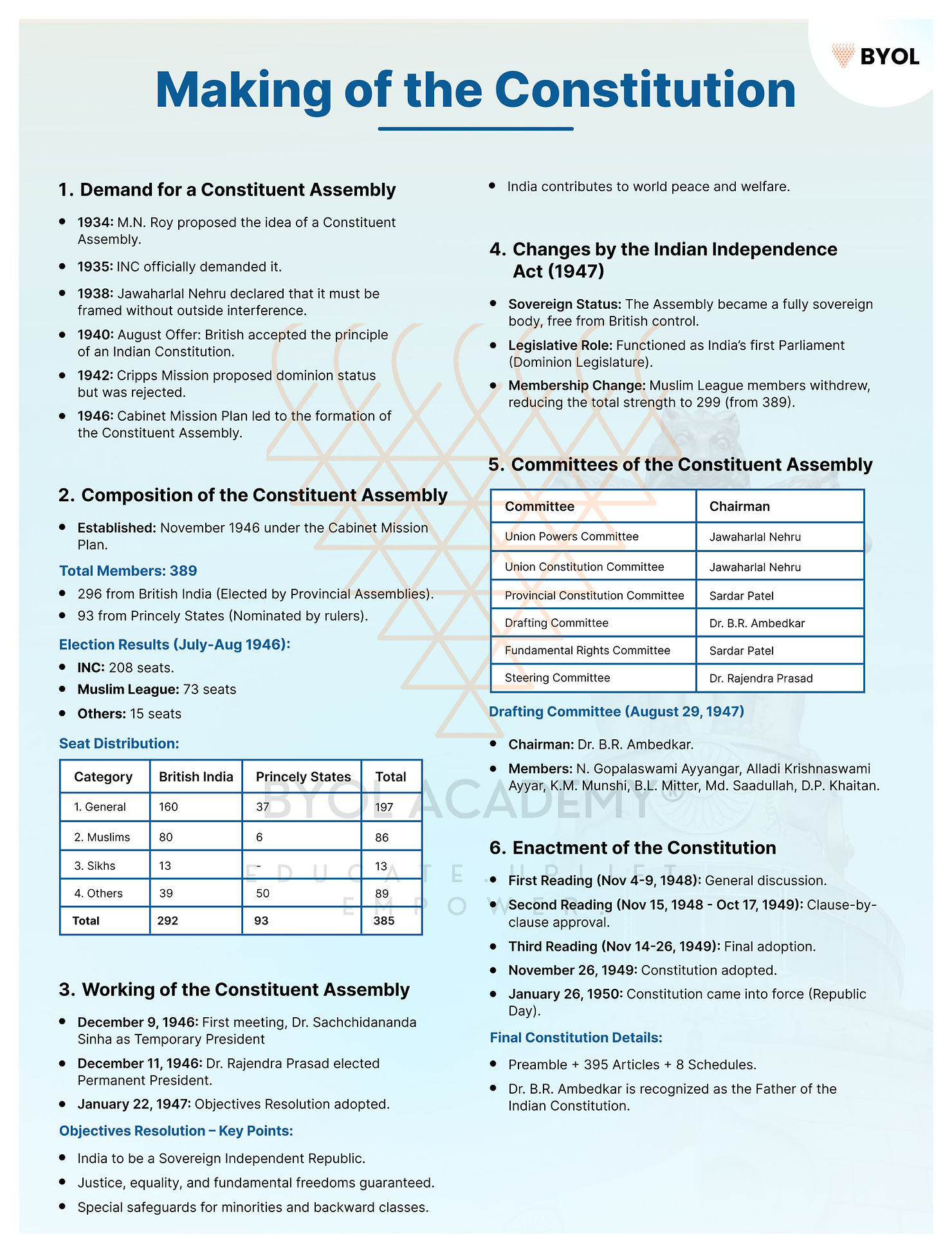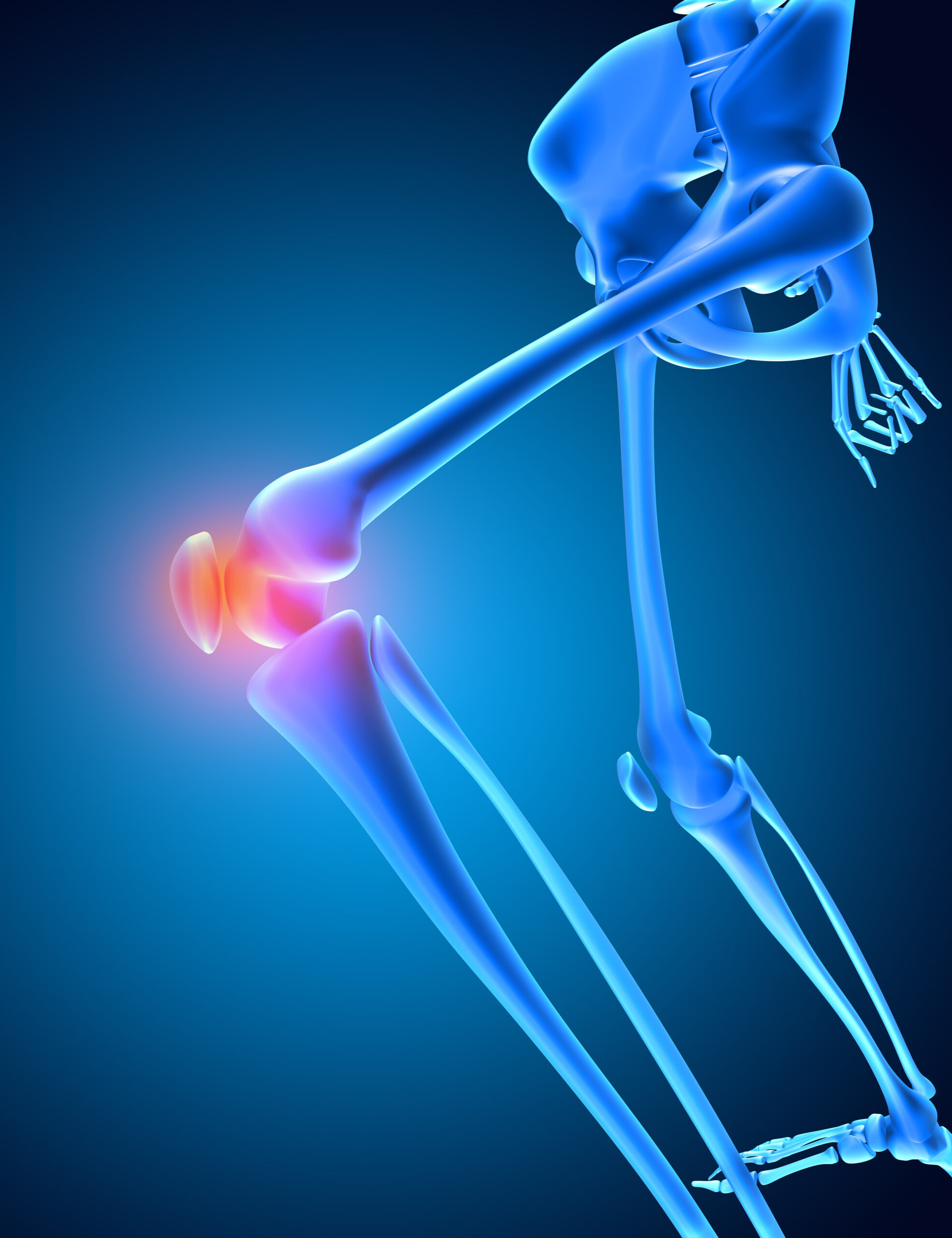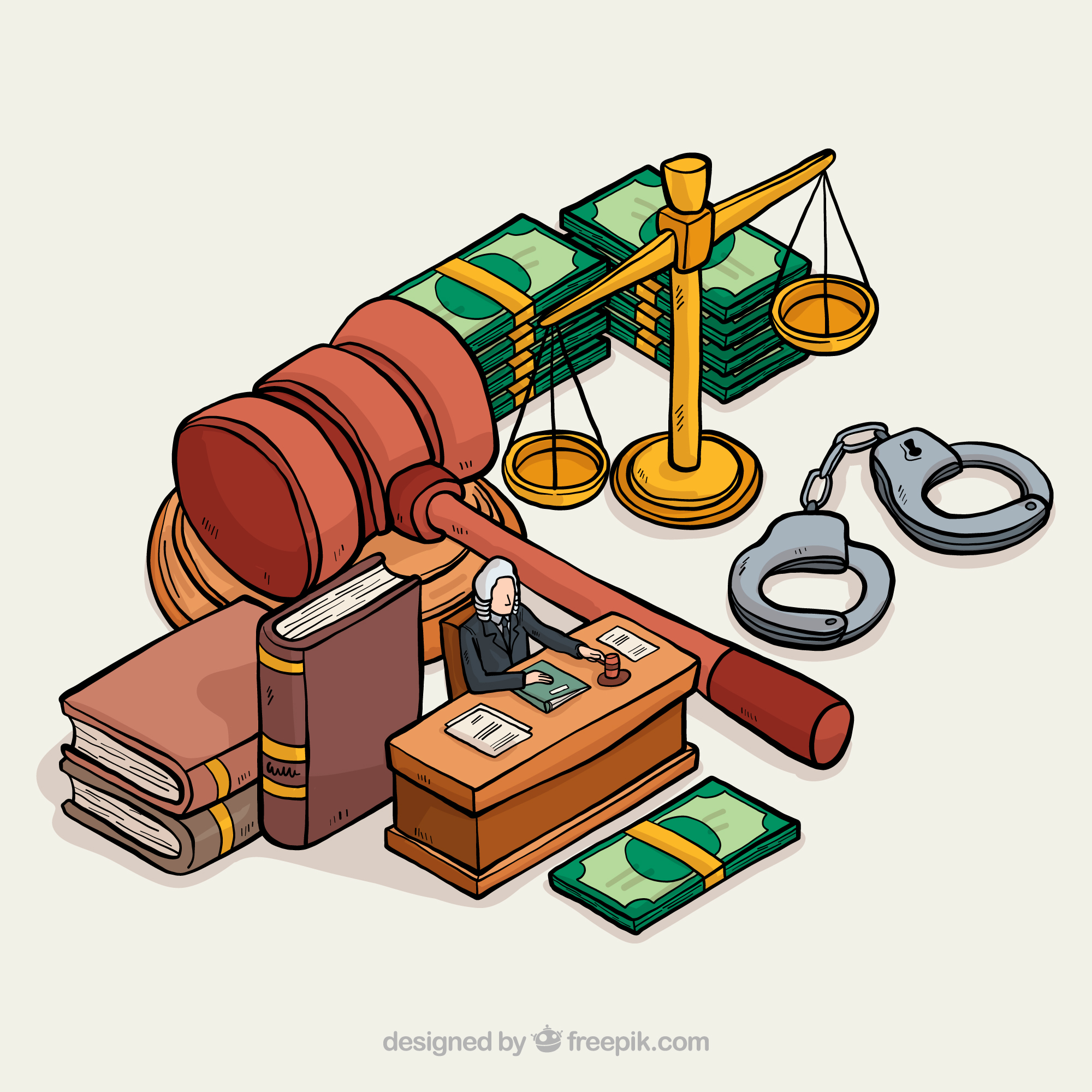Introduction
The Constitution of India is the longest written constitution in the world, framed by the Constituent Assembly (1946-1950) through extensive deliberations. Influenced by global constitutions, it established India as a Sovereign, Socialist, Secular, and Democratic Republic. Led by Dr. B.R. Ambedkar, the Constitution aimed to uphold justice, liberty, equality, and fraternity. Adopted on November 26, 1949, and enforced on January 26, 1950, it laid the foundation for modern India’s governance.
1. Demand for a Constituent Assembly
Background & Evolution
- M.N. Roy (1934): First proposed the idea of a Constituent Assembly.
- Indian National Congress (1935): Officially demanded a Constituent Assembly to frame the Indian Constitution.
- Jawaharlal Nehru (1938): Declared that the Constitution of free India must be framed without outside interference and based on adult franchise.
- August Offer (1940): The British Government accepted the principle of an Indian Constitution.
- Cripps Mission (1942): Proposed dominion status & Constitution-making body, but was rejected by the INC and Muslim League.
- Cabinet Mission Plan (1946): Led to the formation of the Constituent Assembly, rejecting the demand for two separate Constituent Assemblies.
2. Composition of the Constituent Assembly
Formation & Structure
- Established in November 1946 under the Cabinet Mission Plan.
- 389 Members:
- 296 from British India (Elected by Provincial Assemblies).
- 93 from Princely States (Nominated by rulers).
- Elections (July-Aug 1946):
- Indian National Congress: 208 seats.
- Muslim League: 73 seats.
- Others: 15 seats.
- Princely States initially did not participate.
- Indirect elections based on proportional representation.
Seat Distribution
| Category | British India | Princely States | Total |
| General | 160 | 37 | 197 |
| Muslims | 80 | 6 | 86 |
| Sikhs | 13 | – | 13 |
| Others | 39 | 50 | 89 |
| Total | 292 | 93 | 385 |
Election Process
- British provinces – Members were elected by provincial legislative assemblies through proportional representation by single transferable vote.
- Princely states – Members were nominated by rulers.
- Communal representation – Separate representation for Muslims, Sikhs, and General category.
Diversity of the Assembly
- Though not directly elected, it included representatives from all communities – Hindus, Muslims, Sikhs, Parsis, Anglo-Indians, Indian Christians, SCs, STs, and women.
- Mahatma Gandhi did not participate.
Structure of the Constituent Assembly
Constituent Assembly (389 members)
____________________________________
| |
British India (292) Princely States (93)
___________________ _______________
| | | |
Muslims Sikhs General Nominated by heads of Princely States
3. Working of the Constituent Assembly
First Meeting & Leadership
- December 9, 1946: First meeting; Dr. Sachchidananda Sinha elected temporary President.
- December 11, 1946: Dr. Rajendra Prasad elected permanent President.
- Vice Presidents: H.C. Mukherjee & V.T. Krishnamachari.
- Muslim League boycotted the meeting, demanding Pakistan.
Objectives Resolution (December 13, 1946)
- Introduced by Jawaharlal Nehru.
- Laid the foundation for the Preamble of the Indian Constitution.
- Adopted unanimously on January 22, 1947.
Key Provisions
- India to be a Sovereign Independent Republic.
- Union of States comprising British India and princely states.
- Autonomous units with residuary powers.
- All power derived from the people.
- Justice, equality, and fundamental freedoms guaranteed.
- Special safeguards for minorities and backward classes.
- Integrity and sovereignty of the nation maintained.
- India contributes to world peace and welfare.
4. Changes by the Indian Independence Act (1947)
Major Changes
- Sovereign Status: The Assembly became a fully sovereign body and could frame the Constitution without British interference.
- Legislative Role: The Assembly also functioned as India’s first Parliament (Dominion Legislature).
- Dr. Rajendra Prasad chaired the Constituent Assembly.
- G.V. Mavlankar chaired the Legislative Assembly.
- Change in Membership:
- Muslim League members from Pakistan withdrew, reducing total strength to 299 (from 389).
- British Indian provinces: Reduced from 296 to 229.
- Princely states: Reduced from 93 to 70.
Dual Role of the Constituent Assembly
Constituent Assembly (Sovereign Body
————————————-
| |
Constitution-Making Legislative Functions
(Dr. Rajendra Prasad) (G.V. Mavlankar)
5. Committees of the Constituent Assembly
| Committee | Chairman |
| Union Powers Committee | Jawaharlal Nehru |
| Union Constitution Committee | Jawaharlal Nehru |
| Provincial Constitution Committee | Sardar Patel |
| Drafting Committee | Dr. B.R. Ambedkar |
| Fundamental Rights Committee | Sardar Patel |
| Steering Committee | Dr. Rajendra Prasad |
Drafting Committee (August 29, 1947)
- Chairman: Dr. B.R. Ambedkar.
- Members:
- N. Gopalaswami Ayyangar
- Alladi Krishnaswami Ayyar
- K.M. Munshi
- B.L. Mitter
- Md. Saadullah
- D.P. Khaitan
6. Enactment of the Constitution
Stages of Enactment
- First Reading (November 4-9, 1948): General discussion on the draft Constitution.
- Second Reading (November 15, 1948 – October 17, 1949): Clause-by-clause consideration; 7653 amendments proposed, 2473 discussed.
- Third Reading (November 14-26, 1949): Final approval; Constitution adopted on November 26, 1949.
- Signatures: Out of 299 members, 284 signed the Constitution.
Final Constitution Details
- Adopted: November 26, 1949.
- Came into Force: January 26, 1950 (Republic Day).
- Structure:
- Preamble.
- 395 Articles.
- 8 Schedules.
Dr. B.R. Ambedkar’s Role
- Piloted the Draft Constitution in the Assembly.
- Known for logical, forceful, and persuasive arguments.
Recognized as ‘Father of the Indian Constitution’ and ‘Modern Manu’.
7. Enforcement of the Constitution
Provisions Enforced on November 26, 1949
- Citizenship, Elections, Provisional Parliament, Temporary & Transitional Provisions.
- Key Articles: 5, 6, 7, 8, 9, 60, 324, 366, 367, 379, 380, 388, 391, 392, 393.
Full Enforcement on January 26, 1950
- Selected to commemorate Purna Swaraj Day (January 26, 1930).
- Government of India Act 1935 repealed.
- Privy Council Jurisdiction Abolished (1949).
8. Experts Committee of the Congress
Formation & Members (July 8, 1946)
| Name | Role |
| Jawaharlal Nehru | Chairman |
| M. Asaf Ali | Member |
| K.M. Munshi | Member |
| N. Gopalaswami Ayyangar | Member |
| K.T. Shah | Member |
| D.R. Gadgil | Member |
| Humayun Kabir | Member |
| K. Santhanam | Member |
| Krishna Kripalani | Co-opted Member & Convener |
Contributions
- Prepared material for Constituent Assembly discussions.
- Defined autonomous areas, provincial powers, and amending process.
- Granville Austin: Recognized their role in shaping the Constitutional framework.
9. Criticism of the Constituent Assembly
Major Criticisms
- Not a Representative Body: Members were not directly elected by the people of India based on universal adult franchise.
- Not a Sovereign Body: Created under British government proposals and operated with British approval.
- Time-Consuming Process: Took 2 years, 11 months, and 18 days, whereas the American Constitution was framed in just four months.
- Naziruddin Ahmed criticized the Drafting Committee as a “Drifting Committee”.
- Congress-Dominated: Critics claimed that the Assembly was controlled by the Congress Party.
- Granville Austin: “The Assembly was the Congress, and the Congress was India.”
- Lawyer-Politician Domination: Overrepresentation of lawyers and politicians, leading to a bulky and complex Constitution.
- Hindu-Dominated: Some British critics, including Lord Viscount Simon and Winston Churchill, labeled it as a Hindu-majority body.
10. Important Facts about the Constitution
- Symbol of the Constituent Assembly: The Elephant was adopted as its official seal.
- Sir B.N. Rau: Appointed as the Constitutional Advisor to the Assembly.
- H.V.R. Iyengar: Served as the Secretary of the Assembly.
- S.N. Mukherjee: Chief Draftsman of the Constitution.
- Prem Behari Narain Raizada: Calligrapher of the Indian Constitution, handwritten in italic style.
- Nandalal Bose & Beohar Rammanohar Sinha: Artists from Shantiniketan who decorated the original Constitution.
- Beohar Rammanohar Sinha: Also illuminated and beautified the original Preamble.
- Vasant Krishan Vaidya: Did the calligraphy of the Hindi version.
11. Hindi Text of the Constitution
Background
- The original Indian Constitution was drafted in English, and no official Hindi version existed.
- 58th Constitutional Amendment Act (1987) introduced Article 394-A, allowing an authoritative Hindi translation.
Key Provisions of Article 394-A:
- The President shall authorize the publication of:
- The Hindi translation of the Constitution, modified to conform to Central Acts’ Hindi style.
- The Hindi translation of amendments made to the Constitution.
- The Hindi version shall hold the same authority as the original English text.
- In case of discrepancies, the President has the power to revise the Hindi text.
Timeline of Constitution Making
| Year | Event |
| 1934 | M.N. Roy proposed Constituent Assembly |
| 1940 | August Offer promised self-governance |
| 1946 | Constituent Assembly formed |
| 1947 | Independence of India – Assembly becomes sovereign |
| 1948 | Draft Constitution released |
| 1949 | Constitution adopted (November 26) |
| 1950 | Came into force (January 26 – Republic Day) |






